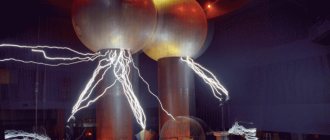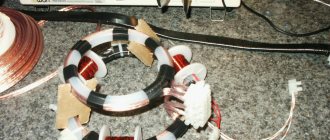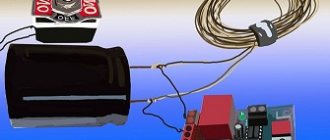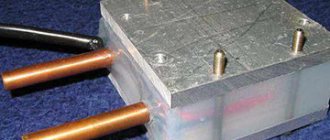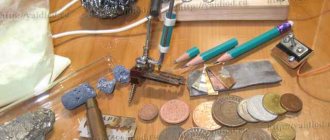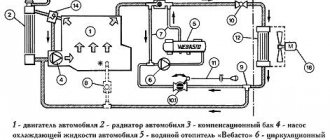Situations with power outages or lack of power supply make you think about a backup power source. Good solution to the problem – buy or make a gas generator with your own hands.
Among all existing generators, gasoline is in first place in popularity.
What are they good for?
- Easy to use;
- Compact and mobile;
- They have high productivity;
- Easy to repair;
- The price is cheaper than diesel generators.
Gasoline generators are used during emergency shutdowns as a replacement for a current source .
They help out owners of dachas and construction sites where power has not yet been supplied, and provide a decent living for geologists, rangers, reindeer herders, drillers - everyone who is forced to work in hard-to-reach areas. A good assistant for home craftsmen in the country or in the garage. They make it possible to replace manual labor with mechanized labor even where the use of electricity is not available. Lighting, electrical appliances and tools, and household appliances are connected through the generator. When connecting devices,
pay attention to the permissible voltage - if the generator is designed for 127 Volts, then devices manufactured for 220 Volts will not be able to operate with the declared power.
The uninterrupted operation time of a gas generator depends on the power of the device, the volume of the fuel tank, and the load size. There are models that can provide operation under load for up to one and a half thousand hours.
Operating principle of an electric generator
The generators operate on the principle of electromagnetic induction, when current is induced in a closed loop due to its intersection with a rotating magnetic field. The magnetic field is created by windings or permanent magnets.
When the electromotive force from the commutator reaches the closed circuit and the brush nodes, the rotor begins to rotate together with the magnetic flux. This creates tension in the spring-loaded brushes pressed against the plate-type commutators.
Next, the electric current is transmitted to the output terminals, passes into the network, and spreads through the generator.
They use alternating and direct current generators. The alternating current electric generator is small in size, does not generate eddy currents, and at the same time has the ability to operate in extreme temperatures. A device with direct current does not require careful monitoring and has a significant number of resources.
Structurally, the generator includes: brushes with brush holders, a commutator, an armature winding, an armature, a starter, contact rings, a starter winding, a rotor, a housing, a fan, a drive and a frame
The alternating current generator can be either synchronous or asynchronous. The first is with a permanent electric magnet and the number of stator rotations is equal to the rotor, forming a magnetic field. The advantages of such a generator are a consistently high voltage; the disadvantages include current overload due to an excessive load on the regulator, which increases the rotor winding current.
Design of an asynchronous generator: squirrel-cage rotor, stator. When the rotor rotates, the generator induces a current, and the magnetic field produces a sinusoidal voltage.
Device
The operating principle of a gasoline generator is based on the conversion of energy obtained from the combustion of gasoline into electrical energy . Components of a gas generator:
- Gas engine;
- Electric motor 127, 220 or 380 V;
- Fuel tank;
- Starter;
- Capacitors;
- Electrical circuit breakers and switches;
- Voltmeter;
- Sockets for connecting electrical appliances.
Industrial models are equipped with additional functions that allow you to control all operating parameters. ATS (automatic input of backup power in emergency situations) is especially convenient. The entire device is mounted on a convenient rigid frame equipped with wheels and handles for transportation. The factory casing is much more beautiful and stronger than the homemade one. Below is a drawing showing all the parts of a gasoline generator.
For those who are well versed in electrical engineering and know how to work with their hands, making a gas generator with your own hands
is not difficult .
For you, Kulibins, a story
How to make a homemade wind generator from a car generator. The activity is quite exciting and it makes economic sense to do it today, so that in a couple of weeks you can receive the first free electric current in your apartment. Or maybe even earlier. It all depends on your quickness. Some minor expenses still await you.
We collect all the components, and only then we begin to work. What do you need to have before you start assembling a wind turbine? It is advisable to have a car generator from more powerful vehicles (bus, tractor). Please note that all components must be purchased as a set: battery, relay, generator from one car.
Since consumers are supplied with alternating current, it is necessary to have a converter or inverter. If the power of this device is 100 watts, then this is quite enough to operate two light bulbs of 40 watts or more. In areas where the wind speed is quite high (the annual average is at least 5.5 m/sec), you can safely install high-power wind generators. But we are talking about low-power wind turbines, for which car generators are quite suitable.
To assemble them you need:
- 12 volt car generator;
- voltmeter;
- battery charging relay;
- material for blades; 12-volt battery;
- locking box for wires;
- four bolts complete with nuts and washers;
- clamps for attaching the generator.
First of all, we make a wind turbine rotor. The best option for a homemade wind generator using a car generator would be to make a rotor wheel from 4 blades. It can be made from sheet iron, even from an iron barrel. The cutting tool is a grinder or grinder.
After making the windmill, we connect it to the generator axis: we drill holes and connect with bolts. Then we assemble the electrical circuit, install the mast, attach the generator and wires, and connect it to the battery and voltage converter. In a word, we do everything as we were taught in school in physics lessons on drawing up an electrical circuit.
Installation of such a wind generator is done quickly, simply and without any special financial costs. A rotary wind generator has its advantages: simple, silent, and reliable in operation. Disadvantage - afraid of hurricane pressure.
Where to begin?
Based on the magnitude of the required loads to simultaneously turn on the devices, all the main elements are selected.
Optimal performance indicators are achieved by correctly selecting the power of gasoline and electric engines.
To obtain a single-phase current of 220 V, a two-stroke gasoline engine is suitable, and if you plan to obtain higher powers, then the choice should be made on a four-stroke. Fuel consumption will depend on the selected engine. In addition to the main task - generating energy, a system for noise reduction, lubrication, ventilation, and installation of an exhaust pipe for removing gases should be provided. You will have to buy wheels to ensure the mobility of the device. The casing can be made of metal or plywood.
Wind generator characteristics
First you need to decide on the desired final result. The characteristics of the electric motor that acts as a generator can be different, and this determines how much electricity the device will generate per unit of time.
To produce an average amount of energy, the generator must have approximately the following characteristics:
- The minimum installation power is 1.3 kW.
- Neodymium magnets in the design are desirable. Their function is to provide electromagnetic driving force. For this purpose, a steel sleeve can be used, which is installed on the rotor.
- The location of the magnets on the rotor must correspond to the diagram. This means that their poles must be turned in the correct direction.
- The rotor shaft must first be ground and adjusted to the diameter of the magnets.
- When installing magnets, it is not always necessary to redo the winding. If it consists of wires with a large cross-section, it’s okay, it will only increase the power. The best winding option would be a device with six poles, a wire with a cross-section of no more than 1.2 mm and a maximum of 24 turns on the coil.
The simplest gas generator
As an example, let’s look at a simple homemade design based on a chainsaw and an electric motor from an old washing machine:
- We attach the electric motor from the washing machine to the chainsaw bar using a specially made stable bracket.
- We put pulleys on the drive shafts of both engines and connect them using a belt drive.
- The button for adjusting the speed of the chainsaw engine, located on the handle, is equipped with an additional device for adjusting the pressing force. A simple bolt secured with a clamp will do the job just fine. To increase the speed, it will be enough to tighten it, and to decrease it, loosen it.
- We connect two capacitors in parallel to the external starting winding of the electric motor, designed for a power of 400-450 Volts.
The video shows a generator with a washing machine engine
This installation, the simplest in its design, is capable of delivering a current of 220 V 180 A , which is enough to power a drill, screwdriver, and lighting fixtures.
Almost any craftsman can make such a basic device. Of course, except for cases when a person does not see the difference between an engine and a carburetor, or the words bracket and container sound the same to him. It is completely unacceptable to manufacture electrical appliances for a person who does not know the differences between the concepts of power (watt), current (ampere) and circuit voltage (volt). More complex designs require fundamental knowledge and skills that will help to correctly calculate engine power, ensure safe use of the finished design, and correctly configure all parameters.
Recommendations for safe use
For generators that will be used in an outdoor environment, for example, a wind power plant, a bicycle generator, protection should be provided from precipitation, dust, and dirt. The device is placed in a special separate housing.
If the generator will operate outdoors for many hours, experiencing daily loads, it needs regular lubrication of the bearings. Manipulations are carried out once or twice every six months.
Short circuits are not permissible: engine wires, auxiliary radio electronics, semiconductors. This can cause the shorted windings to burn out.
If a short circuit occurs, engine repair may be complicated by difficulty in accessing the internal parts of the generator
Engine repair can be complicated by difficulty in accessing internal components due to the force of the rotor, which slows down rotation in proportion to the load. To prevent such situations, you should constantly monitor the engine temperature to prevent it from overheating.
You should also try not to use the device for a long time: the longer the generator is in operation, the less power it has. The optimal engine temperature is from 40 to 45 degrees.
A homemade generator without automatic control devices requires constant user control, including for data collection.
If assembling and using a homemade electric generator seems difficult to you, we recommend that you take a closer look at purchased analogues - the following article provides a rating of gas electricity generators.
Pros and cons of a homemade unit
pros
- The ability to “extend the life” of old engines;
- If repairs are necessary, there will be no difficulties - you know every screw of the design;
- Increased self-esteem - a successfully manufactured functional device will become a source of pride for you;
- Possibility to use as food when carrying out welding work;
- Saving money, replacing manual labor with a more progressive one.
Minuses:
- The process is labor intensive; many operations require special tools and premises.
- When making devices at home, many functions present in industrial designs are omitted.
- If old parts are not available, then purchasing new ones in stores can be too expensive.
- There is no possibility of connecting an ATS (automatic transfer switch).
A homemade gas generator can be a good alternative to factory models in cases where there is not enough money to purchase it or the need for its use arises infrequently. For constant and regular use, it is better to purchase a ready-made gas generator for 220 or 380 Volts with a factory warranty. Unless, of course, remaking various devices and fixtures is your favorite pastime. And it is advisable that you have skills in various jobs - you will need a lot of manual operations, welding and installation work.
Blades
When creating a wind generator, you can easily use a regular PVC plumbing pipe 60 cm long and 15 cm in diameter as blades. Cut it into 4 parts. These will be blade blanks. Then cut a 5x5 square at the base to create the fastener later. To maintain the exact shape and not cut off excess, it is recommended to initially drill a small hole in the right place. Next, simply cut off the excess plastic along the workpiece diagonally. That's it, the first blade is ready.
Use the cut out piece as a template to create the remaining three blades. It will also act as a spare part if something goes wrong. We selected the engine for our wind generator and made the blades. Now we need to make them one.
Final assembly
The generator frame is welded from a profile pipe. The tail is made of galvanized sheet. The rotary axis is a tube with two bearings. The generator is attached to the mast in such a way that the distance from the blade to the mast is at least 25 cm. For safety reasons, it is worth choosing a calm day for the final assembly and installation of the mast. When exposed to strong winds, the blades can bend and break against the mast.
To use batteries to power equipment that operates on a 220 V network, you will need to install a voltage conversion inverter. The battery capacity is selected individually for the wind generator. This indicator depends on the wind speed in the area, the power of the connected equipment and the frequency of its use.
To prevent the battery from being damaged by overcharging, you will need a voltage controller. You can make it yourself if you have sufficient knowledge in electronics, or buy a ready-made one. There are many controllers available for sale for alternative energy production mechanisms.
Advice. To prevent the blade from breaking in strong winds, install a simple device - a protective weather vane.
Scope of application
The undoubted advantages of the gas generator provide it with a wide range of applications:
- during construction and installation works;
- at production sites and repair shops;
- in emergency lighting systems;
- for household work in areas where electricity has not yet been supplied;
- for organizing picnics;
- when providing emergency power supply to hospitals;
- for backup power supply in private cottages.
Gasoline generator in operation
Making a windmill
To create a windmill, you will need to choose one of the design options, of which there are many. Thus, there are horizontal or vertical rotor designs (in this case, the term “rotor” refers to the rotating part of the wind generator - a shaft with blades driven by wind force). Horizontal rotors have higher efficiency and stability in power production, but require a flow guidance system, which in turn requires ease of rotation on the shaft.
Vertical windmills are easier to manufacture and are not picky about wind direction. At the same time, they have less efficiency, since the wind acts with equal force on both sides of the blade, making rotation difficult. In order to avoid this drawback, many different rotor designs have been created, such as:
- Savonius rotor
- Daria rotor
- Lenz rotor
Orthogonal designs (spaced apart relative to the axis of rotation) or helicoidal (blades having a complex shape resembling spiral turns) are known. All these designs have their advantages and disadvantages, the main one of which is the lack of a mathematical model of the rotation of one or another type of blade, which makes the calculation extremely complex and approximate. Therefore, they use the trial and error method - an experimental model is created, its shortcomings are found out, and the working rotor is manufactured taking them into account.
The simplest and most common design is the Savonius rotor, but recently many descriptions of other wind generators based on other types have appeared on the Internet.
The design of the rotor is simple - a shaft on bearings, on the top of which blades are mounted, which rotate under the influence of the wind and transmit torque to the generator. The rotor is manufactured from available materials; installation does not require excessive height (usually raised by 3-7 m), this depends on the strength of the winds in the region. Vertical structures require almost no maintenance or care, which makes the operation of the wind generator easier.
What power plant can be selected for a generator?
First of all - power. In mobile power plants, the following ratio is used: for every kilowatt of electricity generated (not in peak, but in normal mode), 2-3 l/s of the engine is supplied.
Important! This proportion works with properly selected components and minimal losses. It should be remembered that even the most inexpensive generator from the Middle Kingdom was designed by engineers.
As a rule, gas generators are developed as a complex, that is, a generating element is developed for a specific motor. For a homemade installation, you should choose a coefficient of 2-4 l/s per 1 kilowatt of energy. Otherwise, at full load the engine will quickly fail.
In practice, when assembling a power plant “from what was”, home craftsmen often install a motor/generator pair without preliminary calculations. Sometimes there are options for “merging” a fairly powerful engine, on the occasion of buying a bottle of moonshine from a familiar warrant officer, with a motor from a sewing machine. And vice versa.
It is recommended to gather as much technical information as possible about the components before calculating their compatibility.
Important! When calculating the generator/motor pair, the final load power (taking into account the electrical kit and conversion losses) should be taken into account, and not the net power on the generator winding.
Engine from a chainsaw or trimmer
Unpretentious mechanism, very easy to maintain. As a rule, two-stroke.
There are both advantages and disadvantages to such a scheme. On the one hand, you are not worried about the question of what kind of oil to pour into the gas generator (it is added to gasoline, as on old mopeds). Maintenance is virtually non-existent as a class.
Popular: Soldering copper pipes - several methods of implementation

